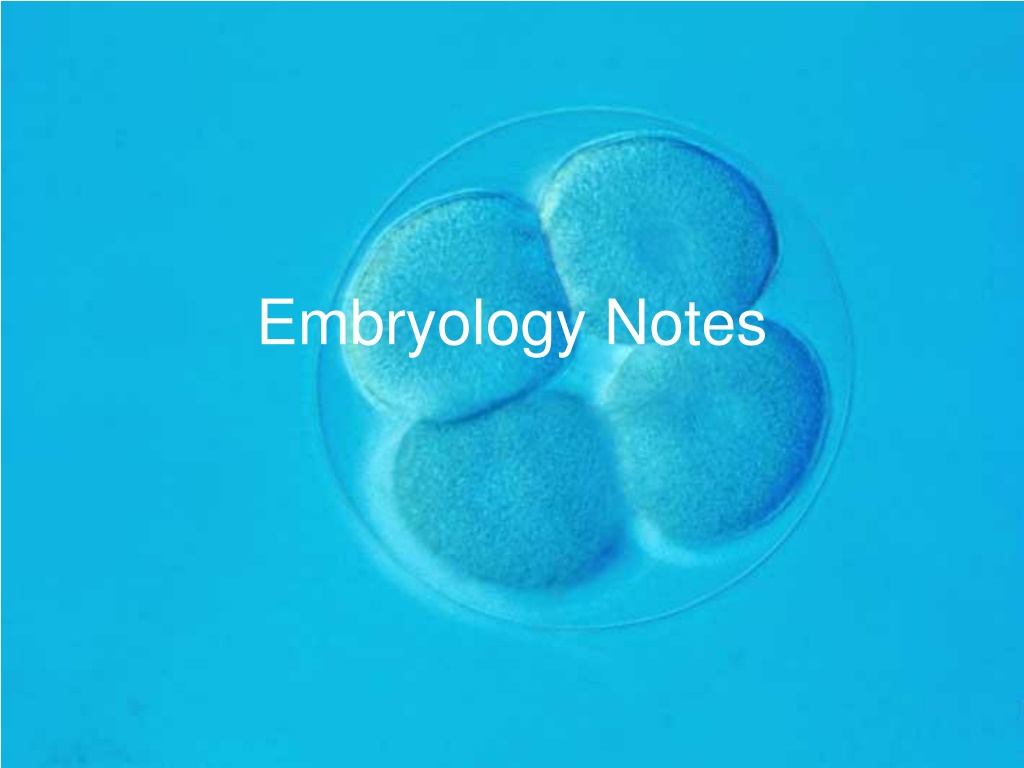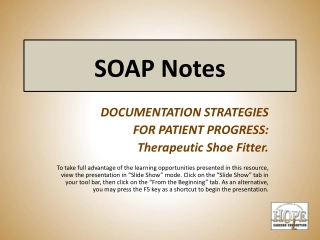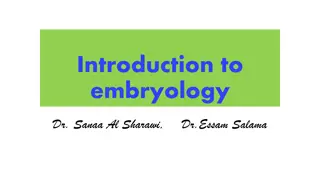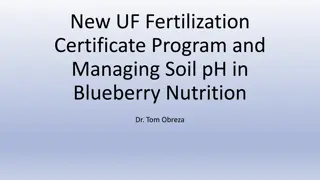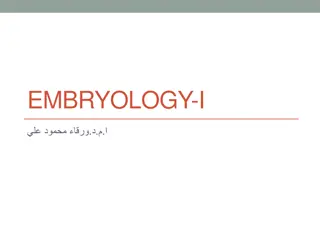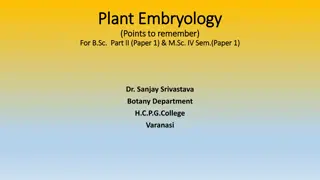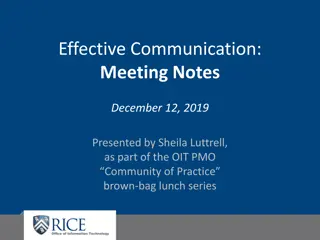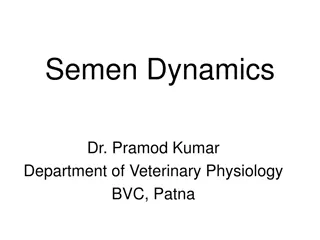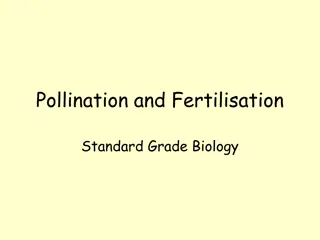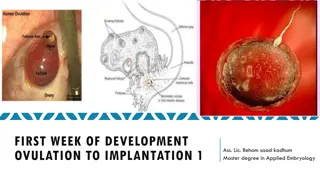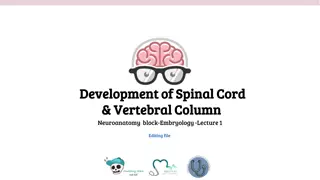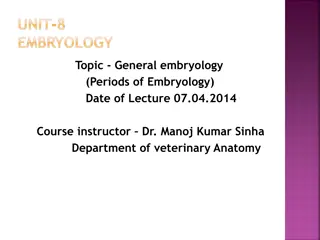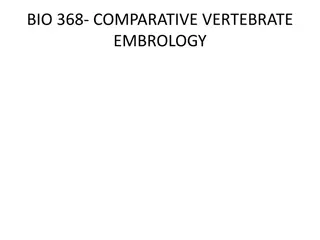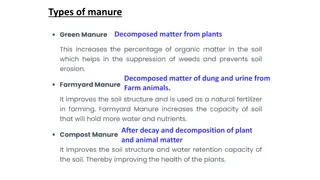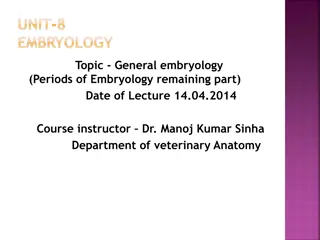Embryology Notes: Development from Fertilization to Gastrulation
Embryology is the study of the development of multicellular animals starting from fertilization when the sperm fertilizes the egg and forms the zygote. This initiates a series of events such as cleavage, morula formation, blastula development, and gastrulation, where three embryonic tissue layers are formed. The process involves intricate cellular interactions and movements leading to the formation of various organs and tissues in the developing embryo.
Download Presentation

Please find below an Image/Link to download the presentation.
The content on the website is provided AS IS for your information and personal use only. It may not be sold, licensed, or shared on other websites without obtaining consent from the author. Download presentation by click this link. If you encounter any issues during the download, it is possible that the publisher has removed the file from their server.
E N D
Presentation Transcript
Embryology Development of a multicellular animal begins with fertilization: fusion of sperm with egg forming zygote Zygote immediately begins to develop triggered by contact between cell membranes
Fertilization Process Sperm cell comes into contact with jelly coat surrounding egg cell Zona pellucida Acrosome (vesicle in head of sperm) releases enzymes that act on jelly coat and membrane of egg Sperm forms a tube that pushes through jelly coat Sperm pronucleus moves into egg cell Egg s membrane becomes impermeable to other sperm cortical reaction Development is initiated
Embryological Development Zygote begins rapid series of mitotic divisions immediately after fertilization cleavage During early cleavage, nuclei cycle rapidly between DNA replication (S phase) and mitosis forms a solid ball of cells called a morula
Newly formed cells (blastomeres) begin to pump Na+ into center of morula Results in the diffusion of water which creates a fluid-filled cavity blastocoel Embryo is now a blastula
Gastrulation An indentation forms on one side of the blastula blastopore Blastula cells migrate in a continuous sheet through blastopore gastrulation Forms three embryonic tissue layers gastrula Ectoderm forms skin and nervous system Endoderm lines digestive tract and forms associated organs (liver and pancreas) Mesoderm forms most organs and tissues (kidney, heart, muscles, inner layer of skin) Blastocoel disappears as a new cavity forms archenteron will become the cavity of digestive tract and blastopore becomes anus
Organogenesis Ectoderm, endoderm, and mesoderm, rearrange themselves into organs Nervous system derived from ectoderm Soon after gastrulation, ectoderm is divided into 2 components: epidermis and neural plate Sheet of ectodermal cells lying along midline of embryo dorsal to newly formed digestive tract and developing notochord bends inward neurulation Forms long groove extending the length of embryo Folds that border groove move toward each other and fuse, converting groove into long tube beneath surface of back Neural tube becomes detached from epidermis and differentiates into spinal cord and brain
There are some differences between the early stages of embryological development in protostomes and deuterostomes Development of coelom from mesoderm follows a different pattern Blastopore becomes the mouth in protostomes and becomes the anus in deuterostomes Protostomes mollusks, annelids, and arthropods Deuterostomes echinoderms and chordates
Post Embryonic Development Degree of development at birth varies between species Some are self sufficient fish, reptiles, amphibians Some need limited amount of care (chicks, ducks) Some are helpless and totally dependent (humans, mammals, many birds)
All organisms undergo major developmental changes after birth Growth usually begins slowly, becomes rapid for a time and then slows or stops Growth does not occur at same rate or same time in all parts of body
Larval Development and Metamorphosis Larval stages many animals go through stages that bear little resemblance to adult Metamorphosis developmental changes that convert immature animal into adult form Involves extensive cell division and differentiation Stage 1 egg Stage 3 pupa After larval development, enter an inactive stage (pupa) Enclosed in a case or cocoon, old larval tissues are destroyed and new tissues and organs develop from small groups of cells imaginal discs Stage 4 - adult Complete metamorphosis all stages including pupal stage Incomplete metamorphosis has a nymph stage Stage 2 larva
Larva Pupa Emerging Adult Adult
Aging and Death Development does not end with mature adult continues until death Aging complex of developmental changes through time that ultimately leads to deterioration and death Factors contributing to aging: Replacement of damaged tissue by connective tissue becomes a burden on other cells Changing hormonal balance may disturb function of variety of tissues Cells tend to accumulate metabolic wastes as they get older
Mechanisms of Development The developmental fate of cells is based on two general principles: 1. The cytoplasmic makeup is not the same throughout the unfertilized egg (differences in concentration of proteins and mRNAs) Helps to establish polarity (animal/vegetal poles) Local differences influence the expression of genes In many species, first few divisions result in totipotent cells retain zygote s potential to form all parts of the animal Determination results in progressive reduction of potency occurs when cytoplasmic environment affects gene expression (cells begin to remember what they are supposed to be)
2.Cell to cell interactions create more differences during morphogenesis Cell interactions may elicit changes in gene expression that occur only among neighboring cells May be accomplished by the transmission of chemical signals or by membrane interactions if cells are in physical contact
Induction The ability of one group of cells to influence the development of an adjacent group of cells Interactions between neighboring cells are crucial during and after gastrulation in the origin of most organs Resulting effect is to switch on sets of genes that cause cells to differentiate into specific tissues
Differentiation Cells begin to specialize in structure and function cell has alterations to cellular structure and has tissue-specific proteins Cells become experts at making certain proteins All cells of an organism have genomic equivalence (have the same genes) Genes that are not used are turned off (usually permanently)
Conclusion: Nuclei change in some way as they prepare for differentiation This change in not always irreversible implying that the nucleus of a differentiated cell has all the genes required for making all other parts of organism Cells of body differ in structure and function because they express different parts of the common genome
